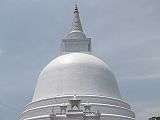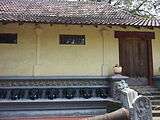Mahiyangana Raja Maha Vihara
| Mahiyangana Raja Maha Vihara මහියංගනය රජ මහා විහාරය | |
|---|---|
 Mahiyangana Stupa is the first stupa of ancient Sri Lanka[1] | |
| Basic information | |
| Location | Mahiyangana, Sri Lanka |
| Geographic coordinates | 07°19′19.4″N 80°59′26.9″E / 7.322056°N 80.990806°ECoordinates: 07°19′19.4″N 80°59′26.9″E / 7.322056°N 80.990806°E |
| Affiliation | Buddhism |
| District | Badulla |
| Province | Uva Province |
| Heritage designation | Archaeological protected monument[2] (22 November 2002) |
| Architectural description | |
| Architectural type | Buddhist Temple |
Mahiyangana Raja Maha Vihara is an ancient Buddhist temple in Mahiyangana, Sri Lanka. It is believed to be the site of Gautama Buddha's first visit to the country, and is one of the Solosmasthana, the 16 sacred religious locations in Sri Lanka.[3] Currently this temple has been declared as one of archaeological site in Sri Lanka.[2]
Buddha's visit
Historical sources, including the ancient chronicle Mahavamsa, record that the Buddha visited the Mahiyangana area in the ninth month after he attained enlightenment, which was his first visit to the country.[4] According to the Mahavamsa, Sri Lanka was inhabited by yakshas at the time. It says that the Buddha subdued the yakshas there and held a discourse on Dhamma with them. They were then sent to an island named Giri so that the country would be "purified" and Buddhism could be established there later on, where it would prevail "in all its glory".[4]
History
A Yakka chieftain named Saman (who is now regarded as a deity) attained Sotāpanna (Sovan) after listening to the Buddha's discourse, and asked for a token from the Buddha that they could worship in his absence. The Buddha had given him a handful of hair from his head, which Saman later enshrined in a small stupa, 10 feet (3.0 m) in height. This was the first stupa to be built in Sri Lanka.[5]
After the parinirvana of the Buddha in 543 BC, an Arahant named Sarabhu brought the Buddha's cervical Spine (Neck bone), which had been recovered from the funeral pyre. This relic was also enshrined within the same stupa, which was enlarged to a height of 18 feet (5.5 m).[5]
Several kings have since renovated and enlarged this stupa, including Dutthagamani[6] who raised it to a height of 120 feet (37 m). Other rulers such as Voharika Tissa, Sena II, Vijayabahu I and Kirti Sri Rajasinha have carried out repairs and maintenance work at the temple. In 1942, a society was formed for the renovation of the temple under D. S. Senanayake. Reconstruction work began in 1953 and ended in 1980 with the completion of a new pinnacle for the stupa.[5][7]
Images
 Mahiyangana Raja Maha Viharaya sub gate
Mahiyangana Raja Maha Viharaya sub gate Mahiyangana Pagoda closer look
Mahiyangana Pagoda closer look Mahiyangana Viharaya Bodhi Tree
Mahiyangana Viharaya Bodhi Tree Mahiyangana Museum
Mahiyangana Museum
See also
References
- ↑ Upali Salgado (29 June 2008). "Tales from the hills of Uva". The Sunday Times. Retrieved 30 September 2014.
- 1 2 "Protercted Monument List 2012-12-12" (PDF). Department of Archaeology. 12 December 2012. Retrieved 27 March 2016.
- ↑ Garnier, Anjalie (2009-05-13). "Ruwanweliseya: Architectural wonder of rich cultural heritage". Daily News. Retrieved 2009-09-29.
- 1 2 Wijesooriya, S. (2006). A Concise Sinhala Mahavamsa. Participatory Development Forum. pp. 5–6. ISBN 955-9140-31-0.
- 1 2 3 Ratnasinghe, Aryadasa (2002-01-28). "Mahiyangana Cetiya - The first of its kind in Sri Lanka" (.pdf). Budusarana. Retrieved 2009-09-28.
- ↑ Aves, Edward (2003). Sri Lanka. Footprint Travel Guides. p. 292. ISBN 978-1-903471-78-4.
- ↑ Dassanayake, M. B. (2002-03-30). "113th Birth Anniversary : Sir Bennet Soysa - the philanthropist of the hills". Daily News. Retrieved 2015-01-11.
External links
- Mahiyangana Rajamaha Viharaya - Official Website
- Mahiyangana Cetiya - the first of its kind in Sri Lanka
- Restoration of Mahiyangana stupa begins
- Miyuguna Seya the first Dagaba in Sri Lanka
- Mahiyangana Cetiya - the first of its kind in Sri Lanka
- The first place visited by Buddha
- First ever stupa built by an Arhant
- EARLY & MIDDLE HISTORICAL PERIODS: 250BC - 1250AD